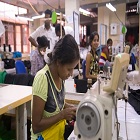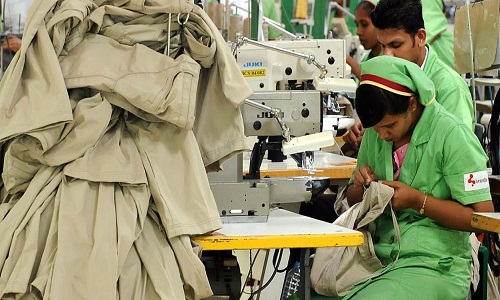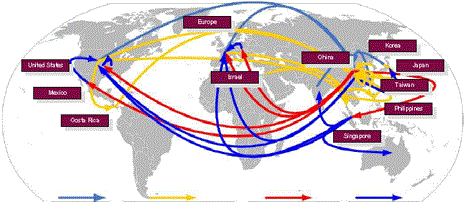FW
Pakistan’s lint production has come down by around 31 per cent. High cost of inputs, weak prices, poor weather, increased pest attacks of pink bollworm and white fly are discouraging farmers from better crop management despite all efforts.
Pakistan is the world’s fourth cotton producer after China, India and the United States. The country’s area harvested is expected to decrease to 2.8 million hectares and yield is estimated at 28 per cent lower.
The decline in lint production has led to a decline in the annual growth of the country this fiscal year. Growth has declined by around 0.5 per cent to five per cent. Pakistan’s cotton production during the 2016 crop year has fallen to its lowest in 17 years, depressed by poor weather and pest outbreaks. This will force consumers to rely on imports to meet end demand.
The country may face a production deficit of around 3.5 million bales. Imports would stand around at 2.75 million bales. Asia is the major cotton producing region. China and India account for 54 per cent of the total world cotton production. India’s 2015-16 crop is estimated at 27.8 million bales, down six per cent from the preceding year on lower area.
After a long struggle, India has succeeded in getting the subsidies on cotton in developed countries eliminated. This will provide a level-playing field for Indian cotton producers. Developed countries have committed themselves to the elimination of subsidies. Apart from this, there will be no more dumping of subsidised cotton into India.
This has been a long-pending demand of Indian farmers and their persistent pressure has finally paid off. Cotton is a very important crop and the very high level of subsidies in developed countries has been a cause of worry for developing countries. Subsidies provided in these countries adversely affect cotton growers in the poorest of the countries. Export subsidies can still be used by WTO members, but only where they used them during the base period (1986-1988).
As India did not have any export subsidies during the base period, it is not entitled to any export subsidies except subsidies aimed at reducing the cost of marketing including internal and external transport as well as handling and processing costs provided that these are not applied in a manner that would circumvent export subsidy reduction commitments. India is not a major user of export subsidies and gave no export subsidy for cotton between 2006-07 and 2009-10.
After a long struggle, India has succeeded in getting the subsidies on cotton in developed countries eliminated. This will provide a level-playing field for Indian cotton producers. Developed countries have committed themselves to the elimination of subsidies. Apart from this, there will be no more dumping of subsidised cotton into India.
This has been a long-pending demand of Indian farmers and their persistent pressure has finally paid off. Cotton is a very important crop and the very high level of subsidies in developed countries has been a cause of worry for developing countries. Subsidies provided in these countries adversely affect cotton growers in the poorest of the countries. Export subsidies can still be used by WTO members, but only where they used them during the base period (1986-1988).
As India did not have any export subsidies during the base period, it is not entitled to any export subsidies except subsidies aimed at reducing the cost of marketing including internal and external transport as well as handling and processing costs provided that these are not applied in a manner that would circumvent export subsidy reduction commitments. India is not a major user of export subsidies and gave no export subsidy for cotton between 2006-07 and 2009-10.
"Sri Lanka’s garment exporters have found a niche thanks to their design-to-deliver supply chain. But the industry could be embroiled in myriad challenges from the fast-changing global trade environment. With the US-led Trans-Pacific Partnership (TPP) trade pact - of which Sri Lanka is not a signatory - on the horizon, competition from TPP signatories such as Vietnam could deal a blow to the South Asian nation’s apparel exports. The industry currently employs half a million Sri Lankans and provides 44 per cent of all manufactured goods exported by the country."

Since 2010, when the European Commission revoked Sri Lanka’s GSP+ status as a penalty for alleged human rights abuses committed at the end of the country’s civil war, the industry has suffered. Even now, heavy investment in a value-added supply chain that enables prompt turnaround has kept the industry going in the face of unfriendly trade treatment.
TPP a challenge for Sri Lanka Sri Lanka’s garment exporters have found a niche thanks to their design-to-deliver supply chain. But the industry could be embroiled in myriad challenges from the fast-changing global trade environment. With the US-led Trans-Pacific Partnership (TPP) trade pact - of which Sri Lanka is not a signatory - on the horizon, competition from TPP signatories such as Vietnam could deal a blow to the South Asian nation’s apparel exports. The industry currently employs half a million Sri Lankans and provides 44 per cent of all manufactured goods exported by the country.

Interestingly, it wouldn’t be the first time the country is up against trade practices that are not in its favor. Since 2010, when the European Commission revoked Sri Lanka ‘s Generalized System of Preferences Plus (GSP+) status, the industry suffered from the loss of preferential tax treatment. Still, heavy investment in a value-added supply chain that enables prompt turnaround has kept the industry going in the face of unfriendly trade treatment.
Design-to-delivery
In Sri Lanka, design-to-delivery time used to be many months till some time back. Now, a chase order for something that’s selling in the US, the country could produce it and ship it across to the stores in 14 days. This is possible as the supply chain is closer to needle point, points out Sharad Amalean, Deputy Chairman, Joint Apparel Association Forum. A design-to-delivery solution means that the design, manufacture and logistics such as delivery are all carried out in Sri Lanka. The country exports about $5 billion worth of apparel a year. Despite this innovation, growth in exports to the European Union -- Sri Lanka’s biggest garment export market -- fell from 13-14 per cent from 2005-2010 to about 7 per cent a year after the GSP+ status was revoked, according to a report by consultancy Oxford Business Group. But Ashroff Omar, Group Chief Executive of Brandix, Sri Lanka’s largest apparel exporter, is hopeful of another about-turn. The exporter shipped $750 million worth of goods to its clients last year.
Omar believes Sri Lanka will regain duty free status by the end of this year, so he is bullish about the European market. Even so, the TPP will deal a blow. Competition with Vietnam, Sri Lanka’s closest garment-making rival, will be particularly stiff. But Sri Lanka may be able to buy some time while hiccups in the TPP’s implementation are ironed out. Sri Lankans believe if it comes, the earliest would be 2018. And there’s a 10-year phase-out period to remove duties on most apparel products.
Banking on the future
Moreover, during this decade-long run-up, costs in Vietnam will likely go up. Omar feels Vietnam does not have unlimited population. However, the trade deal may still impact Sri Lanka’s share of the apparel export pie after all, China grabbed most of Mexico’s share of the global trade when the Multi-Fiber Arrangement, a deal that set quotas on the amount of textiles and clothing developing countries could export to developed countries, expired in 2004. Today, the world’s second-largest economy controls almost 40 per cent of the global $400 billion market.
So, along with expectations Vietnam’s cost base will rise while the TPP is phased in, Sri Lanka’s strategy is to specialize, by focusing on vertically-integrated design-to-delivery solutions not just in the country but also with partners in China and Hong Kong. Exporters like Brandix are also teaming up with industry players in China and Hong Kong to improve overall supply chain management.
Sri Lanka invested in printing, in laundry, in processing - everything the customer needs. Sri Lanka could also reposition itself as a hub for supplier countries in the region, Omar said, noting that neighbors India, Bangladesh and Pakistan were large producers of cotton, yarns and textiles. Sri Lanka’s reputation as a no-sweatshop, ethical garment center was another advantage, Amalean, CEO of MAS Holdings, a garment maker.
High-end brands including Victoria Secrets, Nike, Gap, Marks & Spencer and Ralph Lauren are few who manufacture in Sri Lanka in part due to this reason. While productivity and speed are Sri Lanka’s hallmarks in the current fast fashion landscape, its garment makers are acutely aware that changes are afoot.

A World Bank and OEVD research says GVC-driven policies have been shown to drive productivity growth, create jobs and improve living standards. Under its new 10-year ASEAN Economic Community (AEC) roadmap, ASEAN is on the lookout for ways to accelerate trade facilitation and eliminate trade barriers by 2025. Extensive research has demonstrated the vital role of global value chains (GVCs) in enhancing economic integration and liberalising trade.
GVCs are essentially the practice of vertical integration in which the various stages of a production process are located across multiple countries to minimise marginal costs. This process is dependent on efficient and inexpensive transportation of raw materials and intermediate inputs. From a GVC perspective, this also means that imports are just as important as exports and that a product may undertake multiple ‘value-adding’ journeys across borders before reaching the market. This reality naturally rewards countries with open borders. As firms generally want to maximise their cost advantages, GVCs do not work well with discriminatory trade policies and non-tariff barriers.

ASEAN’s trade policymakers need to shift away from conventional product or sector-specific approaches and move towards GVC-oriented policies, which measure success in terms of increased trade efficiency and reduced transaction costs. While ASEAN deserves credit for discarding sector-specific approaches from the AEC Blueprint 2015, it can take even greater steps towards embracing GVCs as its core policy focus. Complementary policies’ right package can help ASEAN maximise their participation in GVCs, but implementing them in a concerted manner requires extensive cooperation among governments.
ASEAN also needs to operationalise the ASEAN Single Window, which would allow firms to submit all required import, export and transit documentation via a single electronic gateway. At the same time, ASEAN should finalise and rollout the regional self-certification scheme that would enable exporters to self-certify the compliance of their exports with ATIGA’s rules of origin. Implementation of both these items would mark a major step towards reducing customs delays and would facilitate the movement of goods within ASEAN.
Elimination of unnecessary restrictions on product standards and certification requirements is another key step forward. While human health and safety standards should not be overlooked, overly burdensome procedural requirements and domestic standards are unnecessary obstacles to participation in GVCs. ASEAN needs to expedite its efforts towards harmonising ASEAN standards with international standards and developing more mutual recognition agreements, which currently only cover 11 priority integration sectors.
Such measures often reflect a knee-jerk reaction to short-term adjustment costs of ASEAN economic integration. And while policymakers can defend these measures as securing certain segments of the economy, they put the overall competitiveness of their country and the region at risk. Policymakers should also avoid becoming overly fixated on the progress of one element of enabling participation in GVCs. Instead they should consider how pursuing each element of the AEC agenda is supporting the big GVC picture. In this regard, the focus on GVCs under the AEC Blueprint 2025 warrants more attention because it could fundamentally change ASEAN’s thinking around trade policy.
All ASEAN member states must jointly eliminate distortions to trade to enable the ASEAN region to shine as a participant in GVCs. ASEAN can also leverage off existing regional value chains as a way to enhance GVC participation. GVCs provide ASEAN with the opportunity to take on a more ambitious policy agenda and become a more integral part of global trade. By committing to GVCs, ASEAN would send a strong signal to the international community that it is open for business.
A World Bank report suggested that apparel export industry could be an ideal sector where India's female workforce can find more jobs. This was close on the heels of a United Nations Economic and Social Commission for Asia and the Pacific (ESCAP) survey which highlighted the linkage between higher percentage of women workforce and high economic growth.
According to the World Bank report ‘The Stitches to Riches? Apparel Employment, Trade and Economic Development’, export-oriented apparel production in India and other South Asian countries has the potential to create more and better jobs, especially for female workforce.
Women are expected to benefit the most as their share in the total apparel employment is much higher than their share in other industries. A one per cent increase in expected wages in the textiles and apparel industry could raise the probability of women entering the labor force by 18.9 per cent, says the report. South Asia’s top four apparel producers - Bangladesh, India, Pakistan, and Sri Lanka - have made big investments in world apparel trade and account for 12 per cent of global apparel exports. India also has a more diversified export structure and has a well-developed fiber (cotton), textile and apparel manufacturing base.
Given the strong enthusiasm within Chinese market seen at the Spring Edition of Intertextile Shanghai Apparel Fabrics, Messe Frankfurt’s next Intertextile fair – Intertextile Pavilion at the Shenzhen International Trade Fair for Apparel Fabrics and Accessories 2016 – will provide international apparel fabrics and accessories industry with further opportunities to benefit from this time in South China.
Wendy Wen, Senior General Manager of Messe Frankfurt (HK) explained that Guangdong province’s garment production output has been growing rapidly over the last year. In 2015, a total of 6.5 billion units of clothing were produced there, representing a 2.5 per cent growth compared to 2014. Because of this, the demand for apparel fabrics and accessories in the South China market has been steadily increasing.
Exhibitor profile shows that Intertextile Pavilion Shenzhen is particularly popular with Asian suppliers. As of this month, not only have the Taiwan Pavilion, organised by the Taiwan Textile Federation (TTF), and the Korea Pavilion, organised by the Korea Fashion Textile Association (KFTA) and Daegu Gyeongbuk Textile Industries Association (DGIA), confirmed their return but also a debut Japan Zone is also set to be formed by a number of leading Japanese suppliers. A range of high-quality cotton and man-made fabrics for ladieswear as well as causal wear with quick delivery service will be featured in the zone.
Held from July 7-9, 2016 at the Shenzhen Convention & Exhibition Center across 30,000 sq. mt., nearly 700 exhibitors will showcase an array of high-quality fabrics.
Robert Fraley, Chief Technology Officer at biotechnology giant Monsanto, believes communicating science and training next-generation STEM graduates are just as important as doing science. Texas Tech University, hosted a team of six Monsanto executives lead by Robert Fraley recently. Fraley, a much accomplished scientist with World Food Prize and US National Medal of Technology engaged the whole afternoon with researchers and students to talk about the importance of science, communicating science and training next generation workforce with science and technology education.
He emphasized the need for not only geneticists but also people who are trained in social sciences, statistics and data analytics, emphasizing the need for multidisciplinary knowledge in the future R & D industry. Fraley’s group was the first team in the world to put a gene into a plant that resulted in technologies such as Bollgard and Roundup Ready, which basically enhanced the yield of cotton in countries like India, which became the world number in cotton production last year. Nearly 25 per cent of Monsanto’s R&D budget is set aside for collaborations involving start-ups, academia and small businesses.
This March, Monsanto broke ground for a $140 million cottonseed production facility in Lubbock to be operational in summer 2017, will cater to the cotton seed requirement of the whole United States.
By expanding its selection of high-tech fabrics and bringing together, in a single venue, the Interfilière Lyon is consolidating its position. The show that is set to take place from July 9 to 11 at the Eurexpo Lyon, will offer three spaces, designed to offer visitors an opportunity to explore the variety of fabrics on display. These Include the Intimates General Forum, Momenti di Passione and the Innovation Forum.
This session at Interfilière will explore functionality, versatility and technical features for an ultra-modern look with a foothold in the future. Intimates and loungewear will be at the heart of the Forum for the Autumn-Winter 2017-’18 season. New York-based designer, Tina Wilson, has designed a Pop-Up store for Interfilière featuring loungewear and sleepwear inspired by Art Nouveau.
With the EURO 2016 being held in Paris, Interfilière and Mode City are revisiting their birthplace in Lyon for the duration of a summer, transforming Halls 5 and 6 with a sport-inspired show design. The graphic lines of race tracks, light wood panelling and vertical display offer visitors a clear and effective overview of products and trends.
Brugnoli, the leading Italy based producer of stretch knit jersey for swimwear, lingerie, fashion, sports and athleisure, is the Interfilière’s 2016 Designer of the Year in the Beachwear category. Meanwhile, the Momenti di Passione section of the event will be focus on the preview of Summer 2018 trends. This dedicated swimwear, sportswear and activewear space is designed to highlight new products and provide a forward-looking overview of these markets.
In 2005, Pakistan imposed an anti-dumping duty of up to 18 per cent on imported filament yarn from Thailand, Malaysia, Korea and Indonesia. At that time, 17 local yarn manufacturers were operating in the country. Since then the number of local manufacturers has come down to just four units.
In 2005, stakeholders agreed that in order to bring fabric trade under a legal umbrella, the maximum duty on fabric should not exceed 15 per cent. Hence the duty on yarn was fixed at seven per cent. But over the years the duty on yarn has escalated to 11 per cent without any reason, causing distortions and making raw material for the downstream industry more expensive. Yarn merchants say the yarn duty should be brought down to nine per cent to give benefits to the weaving and knitting industry.
Makers of polyester filament yarn in Pakistan can only meet 25 per cent of the downstream industry’s demand, while the remaining 75 per cent requirement is met through imported yarn. Yarn merchants say, the long term solution for dealing with this issue is to modernise and upgrade plants of local manufacturers besides enhancing their capacity to achieve economies of scale. They emphasise the regulatory duty is not the right solution.












